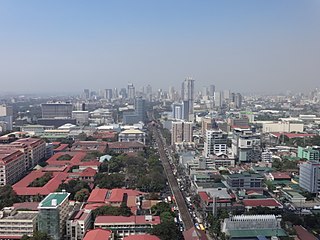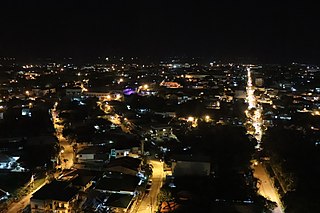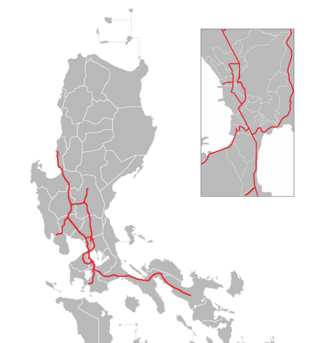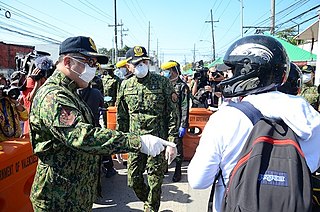
Transportation in the Philippines covers the transportation methods within this archipelagic nation of over 7,500 islands. From a previously underdeveloped state of transportation, the government of the Philippines has been improving transportation through various direct infrastructure projects, and these include an increase in air, sea, road, and rail transportation and transport hubs.

Metropolitan Manila, commonly shortened to Metro Manila and formally the National Capital Region, is the capital region and largest metropolitan area of the Philippines. Located on the eastern shore of Manila Bay, the region lies between the Central Luzon and Calabarzon regions. Encompassing an area of 619.57 km2 (239.22 sq mi) and with a population of 13,484,462 as of 2020, it is composed of sixteen highly urbanized cities: the capital city, Manila, Caloocan, Las Piñas, Makati, Malabon, Mandaluyong, Marikina, Muntinlupa, Navotas, Parañaque, Pasay, Pasig, Quezon City, San Juan, Taguig, and Valenzuela, along with one independent municipality, Pateros. As the second most populous and the most densely populated region in the Philippines, it ranks as the 9th most populous metropolitan area in Asia and the 6th most populous urban area in the world.

Dagupan, officially the City of Dagupan, is a 1st class independent component city in the Ilocos Region, Philippines. According to the 2020 census, it has a population of 174,302 people.

GMA Network is a Philippine free-to-air television and radio network. It is the flagship property of publicly traded GMA Network, Inc. Its first broadcast on television was on October 29, 1961. GMA Network is commonly referred to as the Kapuso Network in reference to the outline of the company's logo. It is headquartered in the GMA Network Center in Quezon City and its transmitter, Tower of Power, is located at Tandang Sora Avenue, Barangay Culiat also in Quezon City with regional stations and offices strategically located in over 9 major cities across the country.

The Metropolitan Manila Development Authority is a government agency of the Philippines responsible for constituting the regional government of Metro Manila, comprising the capital city of Manila, the cities of Quezon City, Caloocan, Pasay, Mandaluyong, Makati, Pasig, Marikina, Muntinlupa, Las Piñas, Parañaque, Valenzuela, Malabon, Taguig, Navotas and San Juan, and the municipality of Pateros.

Mega Manila is a megalopolis on the island of Luzon in the Philippines. There are varying definitions of the megalopolis, but it is generally seen as encompassing the administrative regions of Central Luzon, Calabarzon, and Metro Manila. On some occasions, the administrative region of Mimaropa is also included.

DZBB-TV is a television station in Metro Manila, Philippines, serving as the flagship of the GMA network. It is owned and operated by the network's namesake corporate parent alongside GTV flagship DWDB-TV. Both stations share studios at the GMA Network Center, EDSA corner Timog Avenue, Diliman, Quezon City, while DZBB-TV's hybrid analog and digital transmitting facilities are located at the GMA Tower of Power, Tandang Sora Avenue, Barangay Culiat, Quezon City and Digital SFN towers located in Makati City, Manila, Antipolo City and Angeles City, Pampanga.

DZRV, on-air as Veritas 846 and commonly called as Radyo Veritas, is a radio station owned and operated by the Archdiocese of Manila under the Global Broadcasting System. It is the flagship member of the Catholic Media Network. The studio is located at Veritas Tower, 162 West Ave. cor. EDSA, Brgy. Philam, Quezon City, and its transmitter is located at Brgy. Taliptip, Bulakan, Bulacan, sharing the site of DZXL.
Imperial Manila is a pejorative epithet used by sectors of Filipino society and non-Manileños to express the idea that all the affairs of the Philippines, whether in politics, economy and business or culture, are decided by what goes on in the capital region, Metro Manila, without considering the needs of the rest of the country, largely because of centralized government and urbanite snobbery. Empirical research finds that Imperial Manila and its persistence over time has led to prolonged underdevelopment in Philippine provinces.
AGB Nielsen Media Research Philippines, commonly called AGB Nielsen, under The Nielsen Company is a global leader in audience measurement, market research firms, and data analytics, with a focus on media in the Philippines. Nielsen conducts audience measurements for television ratings in specific areas of the Philippines, particularly in national urban and rural areas.

Metro Davao, officially Metropolitan Davao, is a metropolitan area in Mindanao, Philippines. It includes the cities of Davao, Digos, Mati, Panabo, Samal and Tagum and spanned parts of all five provinces of the Davao Region. Metro Davao is one of three metropolitan areas in the Philippines. It is administered by the Metropolitan Davao Development Authority. It is the largest metropolitan region by land area and the second most populous in the Philippines.

Sucat station is a railway station located on the South Main Line in Muntinlupa, Metro Manila, Philippines. It was originally established by the Manila Railway Company in 1908 as part of the construction of the original Southern Lines to the province of Tayabas, since renamed Quezon. It is also the southernmost area on the PNR Metro Commuter Line to be upgraded to double track as a result of a proposed electrification scheme in 1978.

Metro Baguio, also known as BLISTT, is an agglomeration of the city of Baguio and five municipalities of the Philippine province of Benguet, namely: La Trinidad, Itogon, Sablan, Tuba, and Tublay.
The Lingayen–Lucena corridor is the part of Luzon in the Philippines, between Lingayen to Lucena, comprising the province of Pangasinan, and the regions of Central Luzon, Metro Manila, and Calabarzon, where national elections are claimed to be won. The corridor comprises about 40% of the vote.
Kantar Media Research Philippines, is a market research firm in the Philippines specializing in broadcast media. Kantar Media is responsible for audience measurement of television ratings for the entire Philippines. Kantar Media's main television partner is ABS-CBN.
The Metro Manila Dream Plan, formally titled the Roadmap for Transport Infrastructure Development for Metro Manila and Its Surrounding Areas, refers to a 2014 integrated plan for improving the transport system in Metro Manila, Philippines, with the hope of turning it into a focal point for addressing Metro Manila's interlinked problems in the areas of transportation, land use, and environment.
The third season of The Voice Kids was a Philippine reality singing competition on ABS-CBN. Lea Salonga and Bamboo Mañalac returned to the show as coaches. Sarah Geronimo left the show to focus on her other projects, such as ASAP, and a new album. As a result, Sharon Cuneta replaced her as a coach. Luis Manzano and Robi Domingo returned to host the show; however, Yeng Constantino was replaced by Kim Chiu. Constantino didn't return to the show due to her earlier commitments with some other programs.

The Philippine expressway network, also known as the High Standard Highway Network, is a controlled-access highway network managed by the Department of Public Works and Highways (DPWH) which consists of all expressways and regional high standard highways in the Philippines.

The enhanced community quarantine in Luzon was a series of stay-at-home orders and cordon sanitaire measures implemented by the Inter-Agency Task Force for the Management of Emerging Infectious Diseases (IATF-EID) on the island of Luzon and its associated islands. It is part of the COVID-19 community quarantines in the Philippines, a larger scale of COVID-19 containment measures with varying degrees of strictness. The "enhanced community quarantine" (ECQ) is the strictest of these measures and is effectively a total lockdown.

Metro Clark, also known as Metro Angeles or Metro Clark Angeles, is an urban area in Pampanga, in Central Luzon, Philippines. It is primarily composed of three cities and further supported by 9 municipalities. Its urban core consists of the cities Angeles, San Fernando and Mabalacat. It is a major urban area of the Philippines and is considered the industrial and residential center of Central Luzon.














